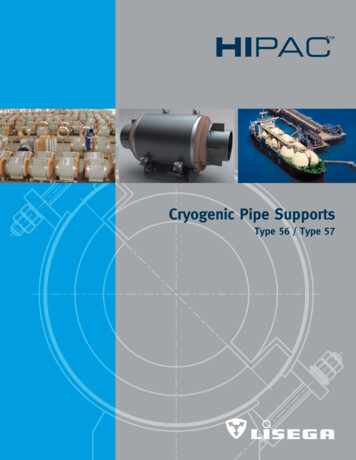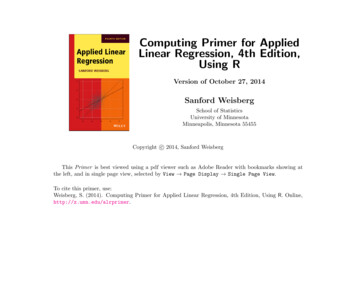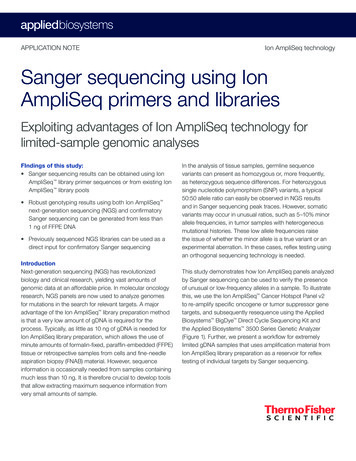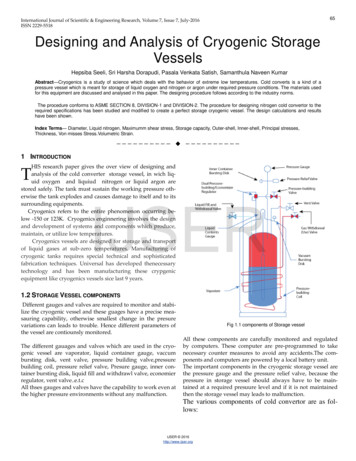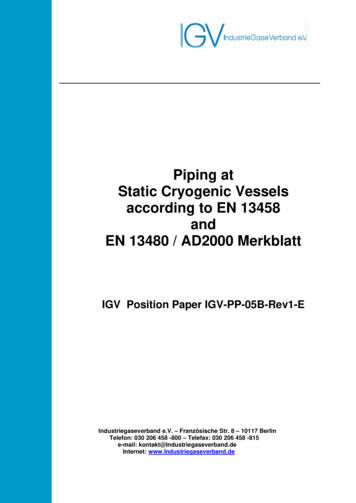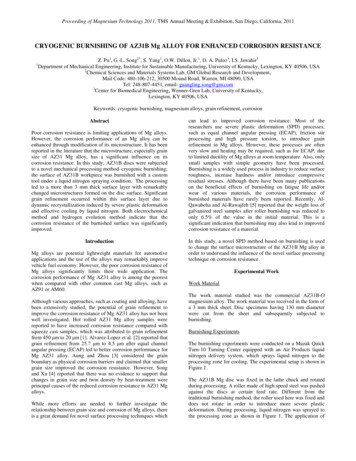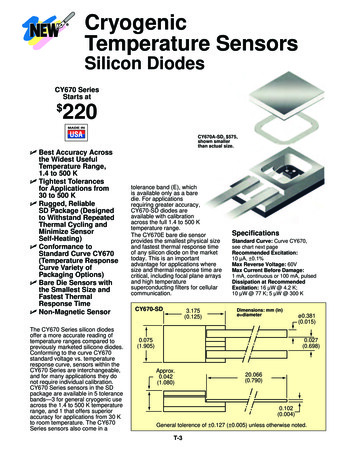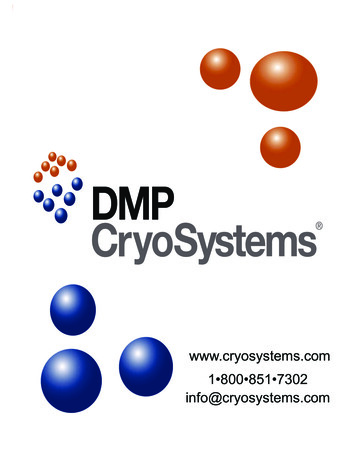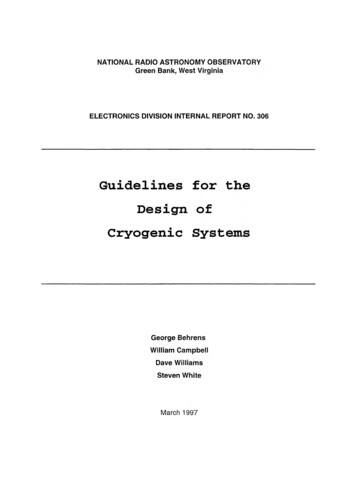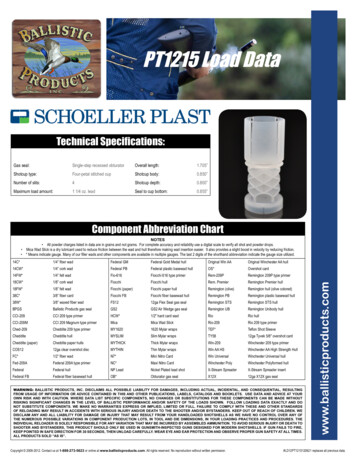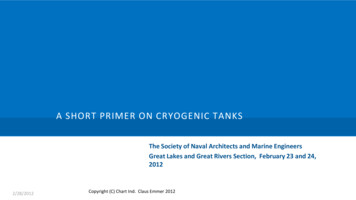
Transcription
A SHORT PRIMER ON CRYOGENIC TANKSThe Society of Naval Architects and Marine EngineersGreat Lakes and Great Rivers Section, February 23 and 24,20122/28/2012Copyright (C) Chart Ind. Claus Emmer 2012
2/28/2012Bio-Medical FacilityMarietta GABulk & Engineered Storage FacilityNew Prague, MinnesotaHeat Exchanger FacilityTulsa, OKEnergy and Chemicals FacilityHouston, TexasEnergy and ChemicalsThe Woodlands, TXHeat Exchanger FacilityLacrosse, WisconsinChart HeadquartersCleveland, OhioEnergy and Chemicals FacilityNew Iberia, LouisianaPackaged Gas FacilityCanton, GeorgiaWHO WE ARE A bit about us .Chart started to buildLNG systems in theearly 1990’s.Chart Europe GmbHSolingen, GermanyFerox a.s.Decin, Czech RepublicChart Cryogenic EquipmentChangzhou, ChinaChart Hailu Cryogenic EquipmentZhangjiagang, ChinaService and Repairs FacilityHolly Springs, GeorgiaLNG WorkSites in Green2Copyright (C) Chart Ind. Claus Emmer 2012 We designs LNG tanks on three continents We design and build liquefiers in the US We design and build ship LNG tanks on twocontinents.
2/28/2012(source: The Guardian)WHY NATURAL GAS?16 largest ships emit as much as all 800million cars in the world. One ship can emit5000 tons of sulfur per year3Copyright (C) Claus Emmer 2011
2/28/2012Volume reduction makes it easier to transportWhy Industry has switched to cryogenic storage And energy density applies to vehicle fuels FIRST, A BIT ABOUT LNGWhy LNG? The main reason to liquefy a gas is for ease of storage andtransportation. It lowers storage costs, since cryogenic storage is at lowpressures. It is easier to pump a liquid than to compress a gas. A 15 HP cryogenic pump replaces a 175 HPcompressor.Of course, this is a nastyexample, since itcompares to steelcylinders at lowerpressures.4Copyright (C) Chart Ind. Claus Emmer 2012But of course, if you compareto Type IV cylinders, they’lltake up only 3 to 4 times thespace, and cost maybe 40%more.
2/28/2012PROPERTIES OF LNGRemember all fuels burn – or they wouldn’t be a fuel Some fueldensitiesSome basic notions LNG is primarily liquefied methane, with some ethane and. propane. Is has no moisture, oil, or odor. It is stored at a temperature of around -259 F andpressures less than 250 PSIG. At room temperature it is lighter than air, and quicklydissipates. Primary hazards are: It’s very cold! It can displace oxygen and act as an asphyxiantCopyright (C) Chart Ind. Claus Emmer tions/lng/LNG primerupd.pdf
2/28/2012 The Mobile Tanker Designed for Road or Rail Road tankers, ISO containers, Rail cars. The Shop built Storage Tank. Vertical or horizontal pressure vessels. Volumes larger than 250,000 gallons are costly orimpossible to transport. Specialized tanks Ship tanks, Vehicle tanksTANK TYPESThe “Flat Bottomed” tank Stores very large volumes at no pressure. Generallycheapest at volumes above 3 billion gallons.6Copyright (C) Chart Ind. Claus Emmer 2012
2/28/2012This is a generic tank.It is the same if it ishorizontal or verticalKEY PARTS OF A CRYOGENIC TANK. Inside it is -256 F, outside it is room temperatureor higher. A difference of more than 300degrees. Heat will transfer:1. By mechanical conduction – the bracingbetween the inner and the outer tank,and the piping between them.2. By Convection – i.e. the gas remaining inthe Annular space. We reduce that bypulling a vacuum.3. By radiation – by using shine surfaces toreflect the radiation. So in tank design we make the mechanicalcomponents as thin as possible – just strongenough for the required conditions. We pull a vey high vacuum – less than 1 millionthof an atmosphere. We minimize radiating by applying multiple layersof reflective materials.7Copyright (C) Chart Ind. Claus Emmer 2012
2/28/2012 Most often used on stationary tanksStraps between the inner andouter are a common supportsystem.The cone support is probablythe strongest, but has thehighest heat leak. Used on mobile equipment and stationary tanksUsed on mobile equipment and stationary tanksA trunnion support is veryeffective, but is a real design andmanufacturing challenge onmobile equipmentCOMMON SUPPORT SYSTEMS Most often used on mobile equipmentInsulating bottom supports veryeffective, but hard to design formobile equipment.8Copyright (C) Chart Ind. Claus Emmer 2012
2/28/2012About here iswhere perlitetanks workCopyright (C) Chart Ind. Claus Emmer 2012Aerogel Beads as Cryogenic Thermal Insulation SystemNASA Tech report, Fesmire & Augustynowicz9About here iswhere SI tanksworkVACUUM To the right are the classic curves showingthe effect of various types of insulation atvarious levels of vacuum on heat leak. The all follow a similar pattern At atmospheric pressure they are allpoor insulators, though Aerogel is abouttwice as effective as perlite and SI. As vacuum increases, they becomerapidly more effective, with SI beingmost effective by a factor of 100 at thelow ranges. Very low vacuum levels are achieved in a“cold” vacuum, when absorbents and gettersin the vacuum space are most effective. Less effective insulation needs to be thicker toget the same insulating effect.
2/28/2012InsulationFiberglass without vacuumFoam without vacuumPowder without vacuumVacuumEvacuated PerliteSuperinsulationR value6.48.36.22560170Lots of manufacturingTechnology neededTo do it rightINSULATION SuperinsulationCommon insulationsCryogenic Insulations for the Distribution of LiquefiedGases. H. M. Lutgen, IOMA 1053 Perlite Some common insulations: FoamThis is the same stuff – butcleaner and dryer – thatyou use in your garden.Foam insulation isgenerally prefabricated10Copyright (C) Chart Ind. Claus Emmer 2012
2/28/2012 Tank Design NEEDS1. A liquid container of materials appropriate forlow temperature.2. Insulation to keep the liquid at that lowtemperature.3. Safety devices to make sure that pressure’sdon’t get higher than the container can handle.4. A method to get the liquid into the tank5. A means to get the liquid out of the tank.6. A method to get excess gas out of the tank.7. Instrumentation to find out what’s happening.8. An outer container to keep the insulation inplace 1. Designed to the proper Codes and regulations2. To be strong enough to hold the liquid at somedefined pressure.3. Supports be strong enough to be transportedfrom the factory to the destination.4. In addition to be strong enough for any serviceconditions.1. Seismic, wind force, road forces, waveforces, vibration, heat, corrosion.5. Thermally efficient design to keep the liquid coldas long as possible.6. Proper safety features for normal operation.7. Design for maintainability.8. Application requirements, such as pump, highflow , etc. (We once built a 15,000TANK DESIGN All Tanks NEED gallon hydrogen tankdesigned to be emptied infive minutes or less.)11Copyright (C) Chart Ind. Claus Emmer 2012
01V-15V-37V-28TANK 1*V-42V-11C-5V-14V-312Copyright (C) Chart Ind. Claus Emmer 2012Typical Piping Schematic*Some of the Basics Fill lines Top and bottom fill lines if pressure needs to beconstant during fill. Top filling lowers pressure Bottom filling raises pressure. Vent lines Relief system Vent system Pressure Control System Regulators and vaporizers Instrumentation Product Withdrawal As gas As Liquid Gas safe vent system Possible re-cooling system.
2/28/2012Holding Time A moving tank has a better non-venting holding time thana stationary tank. If the tank is not moving, the liquid will stratify – coldliquid will sink and warm liquid will rise. The pressure in astratified tank is set by the warmest liquid on the top. Typically, a larger cryogenic tank will rise inpressure around 3 to 5 PSI per day. A road tanker, that is moving and has liquid mixing, risesat around 1.5 PSI per day. They can have a OWTT of over1,000 hours. Consider that the field erected tanks commonlyused in LNG storage are not pressure vessels, andany vapor formed needs to be handled andcontrolled. Shop built tanks – are pressure vessels – and arefilled with a single hose from the top with coldliquid. This cold liquid recondenses any vapor in thevapor space and the pressure in the tank dropscorrespondingly. There is no practical limit to the top-fill rate,other than that it must become slower as thetank becomes fuller, in order not to overfill. Since the tanks are pressure vessels, no vaporneeds to be handled – at worst, the liquid isstored at a slightly higher pressure/temperature. Large horizontal tanks – like the 250,000 gallonunits we build – have a long spray bar todistribute cold liquid evenly along the lengthduring filling.13Copyright (C) Chart Ind. Claus Emmer 2012Filling tanksOTHER QUESTIONS ABOUT TANKS NER – the Boil Off Rate Thermal performance is usually stated in % per day ofevaporated product at atmospheric pressure. Typical NER’s on larger vacuum insulated tanks is on theorder of 0.15 to 0.07 % of capacity per day. Thus a normal 15,000 gallon LNG tank will evaporateabout 15 gallons of LNG per day due to thermalinefficiencies. Larger tanks will have lower heat leak as the volumeincreases faster than the surface area.
2/28/2012TANK CONSTRUCTION (2)14Copyright (C) Chart Ind. Claus Emmer 2012
2/28/2012In Practice Lines that are connected to the liquid side of thetank need to have vapor locks to preventexcessive heat transfer into the liquid. Pressurizing systems need to be sized formaximum withdrawal rates. And liquid flows intopressure building circuits by gravity only, so linesizing and routing is a challenge. Liquid to pump essentially flows by gravity. Trapsin pump feed lines limit this flow. There is a lot of heat generated by pumps.Oversizing a pump is counterproductive. Stainless steel contracts about 1/32nds of an inchper foot when it cools. Improper design can ripthings apart. Liquid trapped between two valves can generatemuch higher pressure than the burst pressure ofa pipe. Proper cryogenic design always includes athermal relief device between two lquid valves. We’re designing and building the entirefuel system for the first high speed turbinedriven dex.htmlTANK DESIGN Some Key thoughts Moving or sloshing will homogenize the liquid andremove any false pressure, stratification, or subcool.15Copyright (C) Chart Ind. Claus Emmer 2012
2/28/2012Key PointsLNG Has no odor.Warm natural gas always rises.Need to ensure that no unwanted gas in unexpectedareas, since there is no odor, nor is odor a reliable meansof detection. Need to protect non-cryogenic steel piping in contact withLNG.Mitigation .Need to have gas detection.Need to have means to dilute natural gas concentrationsNeed to have protection in case of fire – inside or outside.All stainless construction acts as containment, and isimpervious to spills or cold cracking. All key connections fail closed. Piping is either vacuum insulated, or purged doublewalled piping.16Copyright (C) Chart Ind. Claus Emmer 2012 CONSTRUCTION DETAILS
2/28/2012And the ones that docharge accordingly.CONSTRUCTIONComponent selection islimited. Not that manycompanies manufactureDNV certified valves, forexample.The piping is enclosed in a fireproof (or at least resistant,purged control roomThe safety record of double walledcryogenic tanks has been exceptional.And LNG is just another cryogenic liquid.Some say it is safer than Liquid Oxygen.17Copyright (C) Chart Ind. Claus Emmer 2012
2/28/201218Copyright (C) Chart Ind. Claus Emmer 2012BREAKING TANKS Typically, ASME pressure vessels that are in a vacuum – i.e. a non-corrosive environment are used a minimum of 30 years. We sometimes refurbish piping of tanks built in the 60’s In order of priority, vacuum or performance is affected because:1. The vacuum gauge is removed or exchanged improperly causing a slow vacuum leak.2. Insulation has settled. This happens with perlite, not with SI.3. An outer leak on the jacket, due to thermal cycling or contact with cryogen.4. A leak on the annular piping, due to thermal cycling.5. A inner tank leak. Leaks are very easy to find on super insulated tank. And all leaks are easy to fix once they are found.
2/28/2012 There is no effect, since there is no vacuumto loose. But there is a lot of insulation betweeninner and outer tank. To restore vacuumRestoring vacuum on a jacketed tank is easy.1. Use Helium to determine location of leak if it is too smallto be seen or heard.1. Fast with SI Tanks2. A bit more laborious and slower with perlite.2. Fix leak3. Replace getters4. Reactivate absorbents with heat and vacuum.Vacuum jacketed Tanks Equipment Rapid loss of efficiency as annular spacepressures approach 1 atm. Heat leak is in proportion to insulationthickness. Since vacuum insulation (perlite or SI) is soeffective, only a small distance of insulation isneeded. When vacuum is lost the insulation revertsback to that of a thin non-jacketed tank. Good for finding leaks down to 10-8 ccof helium/sec. That number is almost meaninglesslysmall. Moisture can temporarily plugthat hole. And a small pump, up close, has fasterpumping speeds than a big one faraway. Getting molecules out at high vacuumis like having a drunk find a small doorin the dark 19Copyright (C) Chart Ind. Claus Emmer 2012EFFECT OF VACUUM LOSSNon-Jacketed Tanks
2/28/201220Copyright (C) Chart Ind. Claus Emmer 2012REAL VACUUMSAnd you didn’tbelieve me aboutsmall pumps .
1. A liquid container of materials appropriate for low temperature. 2. Insulation to keep the liquid at that low temperature. 3. Safety devices to make sure that pressure's don't get higher than the container can handle. IGN 4. A method to get the liquid into the tank 5. A means to get the liquid out of the tank. 6.
